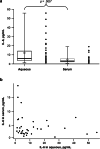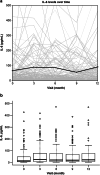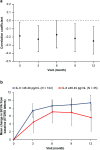Aqueous humour interleukin-6 and vision outcomes with anti-vascular endothelial growth factor therapy
- PMID: 38622330
- PMCID: PMC11156666
- DOI: 10.1038/s41433-024-03015-2
Aqueous humour interleukin-6 and vision outcomes with anti-vascular endothelial growth factor therapy
Abstract
Background: This analysis evaluated aqueous humour (AH) interleukin (IL)-6 concentrations and the association between AH IL-6 and visual outcomes in patients with neovascular age-related macular degeneration (nAMD) or diabetic macular oedema (DMO) receiving anti-vascular endothelial growth factor (VEGF) monotherapy.
Methods: Post hoc analysis of the multicentre, double-masked, randomised HARBOR (NCT00891735) and READ-3 (NCT01077401) trials. HARBOR enrolled treatment-naïve nAMD patients. READ-3 enrolled treatment-naïve/previously treated DMO patients. HARBOR patients received ranibizumab 0.5 or 2.0 mg monthly or as needed; AH samples were collected at month 2, after two previous intravitreal injections. READ-3 patients received ranibizumab 0.5 or 2.0 mg as needed; AH samples were collected at baseline and months 3, 6, 9, and 12.
Main outcome measure: association between AH IL-6 concentrations and month 24 best-corrected visual acuity (BCVA).
Results: In both trials (HARBOR, N = 36; READ-3, N = 137), patients with higher AH IL-6 concentrations had worse visual outcomes. HARBOR patients with low AH IL-6 concentrations at month 2 had a mean (95% CI) BCVA change at month 24 of +2.9 (-2.6, 8.3) letters, whereas patients with high AH concentrations had a mean (95% CI) BCVA change of -9.0 (-22.7, 4.7) letters. READ-3 patients with low AH concentrations at baseline had a mean (95% CI) BCVA change at month 12 of +9.3 (7.4, 11.3) letters, whereas patients with high AH concentrations had a mean (95% CI) BCVA change of +5.6 (2.2, 9.1) letters.
Conclusions: Higher IL-6 AH concentrations may predict suboptimal visual responses to anti-VEGF monotherapy in patients with nAMD/DMO.
© 2024. The Author(s).
Conflict of interest statement
YJS reports being a consultant for Belite Bio, Boehringer Ingelheim, Kriya Therapeutics, and Regenxbio. DVD reports being a consultant for EyePoint, Genentech, Inc., Kodiak Sciences, Novartis, Regeneron, and Santen. MM and SF are employees of F. Hoffmann-La Roche Ltd. BD, SB, and IS are employees of Genentech, Inc. RA and MSH are employees of Ocular Imaging Research & Reading Center. KH was an employee of Genentech, Inc., during the course of this study (current employee of Immune-Onc Therapeutics, Inc.). EW was an employee of Genentech, Inc., during the course of this study (current employee of E.W. Consulting). QDN reports being a consultant for Genentech, Inc., Kriya, Regeneron, Rezolute, and Santen.
Figures




References
Publication types
MeSH terms
Substances
Grants and funding
LinkOut - more resources
Full Text Sources
Medical

